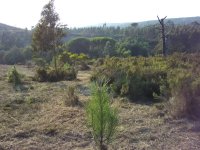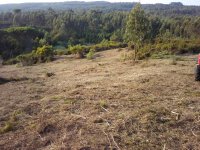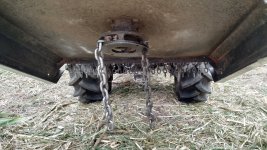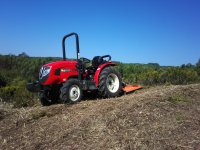jjp8182
Platinum Member
All else fails a tractor mounted saw like this one: TRACTOR SAW | DFM
-- may work though it wouldn't cover the full width of the tractor. Of course on the other hand it also wouldn't necessarily leave a mass of cut off partially busted up stumps....
Alternatively if they don't have spikes that would puncture the tractor tire a simple box blade may even do wonders. It's approach I've used on fibrous weeds that were 6-8ft tall & much more dense spacing with the the occasional small sapling of <1.5 inches in it. Just backed into the mess, dropped the box blade (rippers fully extended) and went forward ripping out all vegetation.
However, with the trees it might be worth using a bucket/grapple to push them over so they don't damage the underside of the tractor, but the rippers on a box blade should be able to pull them out by the roots ...if not at full width, then at least at a partial width. On that note a root rake design may also do the trick, though that might also be a bit more that a tractor loader is designed to really do (unlike a box blade which is meant to be drug through dirt to no end).
Of course if this is a one time task, it may also be worth looking at renting different options -- or even hiring it out (if it's cheaper). As nice as it is to buy new equipment, buying for a single time use is something that should really be weighed against other options..... For example, in my area I could rent a JD 450K bulldozer (with delivery) for a 40hr week for about the same/less as buying a new heavy duty 5ft-6ft rotary cutter ...and based on my experience with that vegetation odds are a clearing a couple acres wouldn't take more than a few days with the dozer (and at less than $550/day rental)
However, if this is also intended to be routinely used it may be worth looking at a small batwing rotary cutter like the Rhino AG TS10 (seen them cut through some pretty significant brush on the youtube "Tractor Time with Tim" channel).
On that note, these are just some suggestions and ultimately how you approach it is up to you as you're the one footing the bill and have the best knowledge of the terrain (and what you're willing to do).
-- may work though it wouldn't cover the full width of the tractor. Of course on the other hand it also wouldn't necessarily leave a mass of cut off partially busted up stumps....
Alternatively if they don't have spikes that would puncture the tractor tire a simple box blade may even do wonders. It's approach I've used on fibrous weeds that were 6-8ft tall & much more dense spacing with the the occasional small sapling of <1.5 inches in it. Just backed into the mess, dropped the box blade (rippers fully extended) and went forward ripping out all vegetation.
However, with the trees it might be worth using a bucket/grapple to push them over so they don't damage the underside of the tractor, but the rippers on a box blade should be able to pull them out by the roots ...if not at full width, then at least at a partial width. On that note a root rake design may also do the trick, though that might also be a bit more that a tractor loader is designed to really do (unlike a box blade which is meant to be drug through dirt to no end).
Of course if this is a one time task, it may also be worth looking at renting different options -- or even hiring it out (if it's cheaper). As nice as it is to buy new equipment, buying for a single time use is something that should really be weighed against other options..... For example, in my area I could rent a JD 450K bulldozer (with delivery) for a 40hr week for about the same/less as buying a new heavy duty 5ft-6ft rotary cutter ...and based on my experience with that vegetation odds are a clearing a couple acres wouldn't take more than a few days with the dozer (and at less than $550/day rental)
However, if this is also intended to be routinely used it may be worth looking at a small batwing rotary cutter like the Rhino AG TS10 (seen them cut through some pretty significant brush on the youtube "Tractor Time with Tim" channel).
On that note, these are just some suggestions and ultimately how you approach it is up to you as you're the one footing the bill and have the best knowledge of the terrain (and what you're willing to do).






